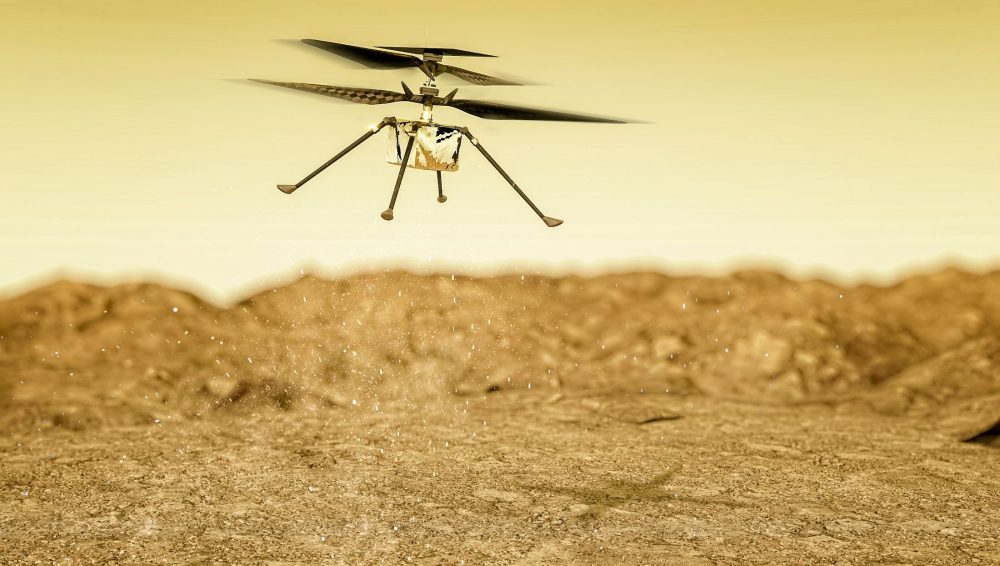
Carbon fibre composites are used in many ways in spacecraft; they are used on launch vehicles, Martian probes, satellites, and re-entry vehicles. Rockets themselves are incredibly sensitive to weight; consider that 94 tonnes of propellant are required in a SpaceX rocket to lift 22 tonnes to low Earth orbit, or to send just 4 tonnes to Mars. As the distance that a spacecraft has to travel increases, every extra kilogram of weight only becomes more crucial.
Martian Vehicles Using Carbon Fibre
Several Martian vehicles, in use, discarded, and readying for launch, incorporate carbon fibre composites into their structures.
The Curiosity rover, which landed in August 2012, travelled to Mars enclosed within a protective clamshell made partially from carbon fibre composites. This clamshell, which in addition to protecting the rover during its travel through deep space, protected the rover from the extreme heat and high wind speeds of entry into its atmosphere. This, however, was not the most impressive application of carbon fibre on board this vehicle.
In order to land the rover on Mars, the composite clamshell was discarded, revealing an aptly named “Sky Crane”. This Sky Crane suspended the rover below it with high strength cables, while slowing itself and the rover down to a hover just above the surface of Mars, in order to gently place the rover down without damaging any sensitive components. This Sky Crane used pultruded carbon fibre composite spars around its periphery to mount its rocket engines.
The Perseverance rover, which landed in 2021, used a similar Sky Crane and carbon-fibre composite enclosure. This time, however, the use of carbon fibre was even more daring; the Perseverance rover deposited a small helicopter called Ingenuity on the Martian surface – the first propeller-powered aircraft on Mars.
While not overly heavy, at 1.8kg, Ingenuity has to contend with a Martian atmosphere that is less than 1% as dense as that of Earth, meaning that its woven carbon fibre composite propellers have to move significantly faster than those of a helicopter on Earth to move a sufficient mass of gasses to gain lift. For that reason, Ingenuity’s contra-rotating propellers have to spin at 2400 RPM, between five and ten times as quickly as a helicopter on earth. All of this, while maintaining minimal weight and ensuring structural integrity.
Metal or glass composite propellers would struggle to reach a sufficient RPM with the lightweight motor aboard Ingenuity, rendering flight impossible. In addition, the carbon fibre composite propellers have to withstand the large temperature fluctuations on the Martian surface, between 20°C and minus 73°C, which could risk stress fractures from repeated expansion and contraction.
Launch Vehicles Using Carbon Fibre
There are a number of flight-proven and in-development launch vehicles made from carbon fibre composites. The most well-known example is Rocket Lab’s Electron rocket, built from the outset to take full advantage of carbon fibre’s attributes. It regularly launches 300kg payloads to Earth orbit from their facility in New Zealand.
However, they have a more ambitious rocket in development called Neutron, which will also employ carbon fibre composites as its primary construction material. The Neutron is designed to launch up to fifteen tonnes to low Earth orbit, or 8 tonnes with reuse. This means that Rocket Lab is confident that the first stage, which will re-enter the atmosphere at extremely high speeds and will also have a full carbon fibre construction, to withstand the intense heat of re-entry without any significant deterioration of the carbon fibre composite.
When this rocket enters service, it will be the first reusable carbon fibre composite rocket in service. It is also planned to support future human spaceflight, meaning that it also has potential to be the first carbon fibre composite rocket relied upon to safely launch humans into space, showing how strong and reliable carbon fibre composites can be.
There are other carbon fibre composite rockets in development, including two which are planned to launch from the UK. These include Orbex’s Prime rocket, and Skyrora’s Skyrora XL rocket. Orbex’s Prime rocket, as an example, will use a small carbon fibre composite tank holding liquid propane, which sits within a larger carbon fibre tank holding liquid oxygen. Here, the carbon fibre composite tanks are being relied upon to maintain structural integrity under two exceedingly difficult conditions simultaneously. The first is the cryogenic temperatures, which can make materials far more brittle than at room temperature. We have written about carbon fibre pressure vessels before.
The second, which is where carbon fibre composites excel, is the intense G-loading that all rockets are subjected to. At peak acceleration during launch, they can surpass 7g, meaning that the carbon fibre composite tanks have to withstand forces equivalent to more than seven times the weight of the fuel they hold. Withstanding these immense stresses is something that carbon fibre composites excel at, as well as maintaining rigidity throughout the intense vibrations created during launch.

